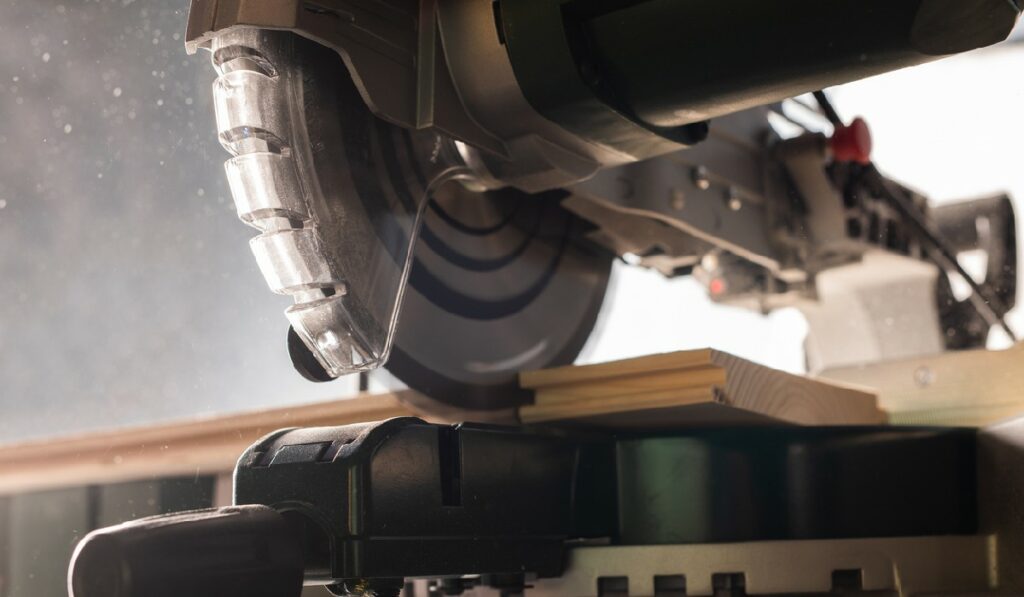Miter Saw Basics: What Is It and When To Use It

People of all levels and experience can benefit from a miter saw. Whether you’re an expert builder, a novice woodworker, or someone who loves DIY projects, a miter saw can help you make precise cuts quickly and efficiently. In this post, we’ll discuss the basics of miter saws, why you need one, and the different types of miter saws on the market today.
We’ll give you an overview of miter saw components, so you can find the perfect one for whatever project you’re working on. Choosing the right miter saw can be the difference between a successful project and one that’s a disaster. Make sure you read this before buying a miter saw.
Definition of a Miter Saw
A miter saw is one of the most commonly used power saws in woodworking and carpentry. It is so common because it can make cuts at an angle, as well as make compound miter cuts. The most common type of miter saw is the compound miter saw, which has a rotating table and pivoting blade that allows for angle and bevel cuts in a single operation.
The two main types of miter saws are the basic sliding miter saw and the compound miter saw. The sliding miter saw has a stationary blade with a pivoting arm that moves the saw forward and backward to make crosscuts. The compound miter saw is more versatile, as it can make both angle and bevel cuts in one pass due to its rotating table and pivoting blade.
Miter saws are most commonly used for cutting small pieces of wood or trim, such as picture frames, crown molding, and trim work. They are also often used when making furniture, cabinetry, window frames, or door frames.
Basic Features of a Miter Saw
Blade
The blade on a miter saw is typically circular. The size of the blade determines the maximum depth of cut that can be made with the saw. Most blades are made of steel or carbide and have either fixed teeth or variable speed teeth, which are optimized for different materials.
Miter Angle
The miter angle is the angle at which the blade makes its cut relative to the face of the material. On compound miter saws, there is an angle adjustment knob and locking lever, which allow you to make adjustments to the desired angle before cutting begins.
Bevel Angle
The bevel angle on a miter saw is the angle at which the blade makes its cut relative to its baseplate. On compound miter saws, there is usually an adjustable bevel angle lever that allows you to customize your cut to the desired angle before cutting begins.
Safety Considerations
When using any power tool, it’s critical to take safety precautions to avoid potential injury or damage to yourself or your material. It’s important to use a blade appropriate for the material. If you’re unsure what blade to use, check with your local home improvement store or the owner’s manual for your particular model.
It’s also important to wear appropriate safety gear when using a miter saw, such as goggles or safety glasses, gloves, and hearing protection. When making long cuts with a compound miter saw, it’s important to use clamps on either side of the material to ensure it doesn’t slide off during operation.
Common Uses of a Miter Saw
Picture Frames
Miter saws are ideal for making picture frames due to their ability to make precise angled cuts. Making compound miters makes it possible to create detailed frame designs that would otherwise require multiple separate cuts.
Crown Molding
Miter saws are great for cutting crown molding because they can make angled cuts quickly and accurately. They allow you to customize your crown molding design without needing additional tools. Compound miters also come in handy since they enable you to create intricate designs without creating separate line angles.
Conclusion
Miter saws are some of the most versatile and helpful tools for woodworking, carpentry, and DIY projects. With the ability to make precise angled and compound miter cuts, they make every job easier and faster. Whether you are a professional woodworker or a hobbyist, a miter saw is an indispensable tool and will help you take your next project to the next level.
